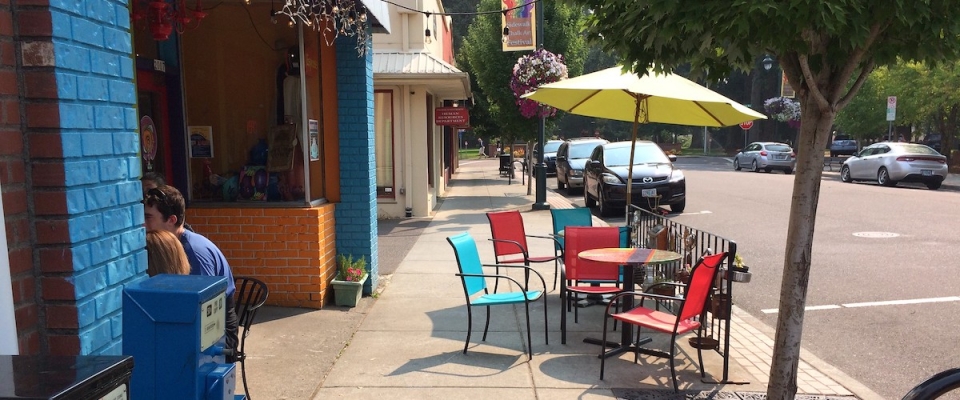Economic Study of 12 Active Transportation Projects in Oregon Finds Solid Returns on Investment

Active transportation investments offer many types of benefits related to safety, reduced greenhouse gas emissions, physical activity and the economy. Metro, Oregon’s regional government for the Portland metropolitan area, wants to better understand the role of these investments in building stronger communities in their region, and in implementing the Metro 2040 Growth Concept.
Led by Portland State University in partnership with Metro, the Active Transportation Return on Investment (ATROI) study looked at twelve projects constructed in the greater Portland region between 2001 and 2016. These twelve 2040 Catalyst Projects were evaluated to determine if active transportation investments had significant effects on the local economy. 2040 Catalyst Projects retrofit busy commercial streets with pedestrian-friendly treatments to catalyze economic development within 2040 Centers, Main Streets, or Station Communities.
Redesigned streets can improve economic conditions by creating attractive and walkable business districts, providing access to various destinations, local businesses, and jobs. Nearly all the projects focus primarily on pedestrian improvements, such as improved sidewalks (new, widened, etc.), safer crossings (signals, rectangular rapid flash beacons, curb extensions, crosswalks, signage, ramps, etc.), improved bus stops, landscaping (trees, bioswales for stormwater management, etc.), lighting, and public art. A few projects also included new or restriped bike lanes, shared lane markings, and/or bike parking.
PSU researchers Jennifer Dill, Jenny Liu and Marisa Zapata evaluated two main components:
- A quantitative analysis on the economic benefits of 12 active transportation projects on busy commercial streets.
- A qualitative assessment of the projects to help tell the story and understand other benefits and impacts of each project. This was conducted through stakeholder interviews, online surveys, and existing feedback recorded from other projects (intercept surveys, surveys of residents of TODs, etc).
"Taking both a quantitative and qualitative approach was important, so we could better understand the numbers and hear directly from the people, including customers and business owners, about the value of the projects. However, our work was done mainly in 2020, so we had to get creative in how we found those people, including an online survey and social media.," Dill said.
Overall, the research team found positive effects on business activity in the retail and/or food sectors, demonstrating that the potential economic benefits are not just in more urban parts of the city of Portland:
- 75% of the project locations saw measurable economic gains in the food or retail industries after implementation.
- Layering complementary investments (e.g. light rail stations and transit oriented-development) has the potential to yield the greatest benefits.
- The projects that did not see positive effects tended to have higher traffic volumes and/or speeds. Projects are more likely to reach their full potential when they reduce the effects of an auto-oriented environment and create places for walking that are also less stressful and more comfortable.
"The findings reveal that these types of investments can have positive outcomes in places outside of downtown and inner Portland, particularly when coupled with other planning and infrastructure investments, but that we do need to address the negative effects of high speed, multi-lane arterials," Dill said.
Together they help us understand many of the benefits of these recent active transportation projects that used regional flexible funding in the past. One of the most important outcomes of the study is informing the region’s decision makers, business owners, and the general public in the recent public comment period for Metro’s Regional Flexible Funding Allocations (RFFA) for transportation projects. With 29 project proposals on the table, it’s important to have the context and data on what has been effective in the Portland region.
ABOUT THE PROJECT
Active Transportation Return on Investment Study
Jennifer Dill, Jenny Liu, and Marisa Zapata; Portland State University
- Visit the Active Transportation Return on Investment (ATROI) study page to download the full report, four-page fact sheet, appendix of the technical report, and bikeway case studies.
- Watch a recording of our Friday Transportation Seminar with Dill and Liu.
The study was funded by Portland Metro and conducted by researchers at PSU and Metro, with report design from Alta Planning + Design. The PSU team included Jennifer Dill, Jenny Liu, Marisa Zapata, Minji Cho, Kyuri Kim, Natalie Chavez, Natalie Knowles, and Lacey Friedly.
Photo courtesy of Oregon Metro.
Portland State University's Transportation Research and Education Center (TREC) is home to the U.S. DOT funded National Institute for Transportation and Communities (NITC), the Initiative for Bicycle and Pedestrian Innovation (IBPI), PORTAL, BikePed Portal and other transportation grants and programs. We produce impactful research and tools for transportation decision makers, expand the diversity and capacity of the workforce, and engage students and professionals through education and participation in research.


